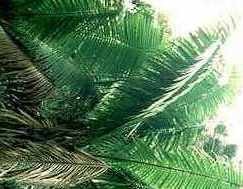Ivory Nut Palm
(Phytelephas macrocarpa)

Description
Phytelephas macrocarpa is a single-stemmed, unarmed, reclining or erect palm from the extreme northern coastal regions of South America, growing to some 12 m tall. It has been introduced and cultivated in tropical regions all over the world. The trunk is about 30 cm across, with prominent leaf scars. The crown is made up of about 30 plume-like leaves or fronds, each about 8 m long, dead leaves being persistent. It is one of some 7 species of palm in the genus Phytelephas, all of which have been exploited for vegetable ivory or tagua from the seed or corozo nut. The closely related Ammandra decasperma from Colombia, and Aphandra natalia from Ecuador, are also sources of vegetable ivory, but of inferior quality and therefore not commercially significant. 'Phytelephas macrocarpa' translates to ‘elephant plant’ with 'large fruit', the endosperm of the nut having the texture of elephant ivory, and consisting of large, thick-walled cells of two long-chain polysaccharides, mannan A and B. The species is dioecious, male and female flowers growing on different trees. Flowering and fruiting are not seasonal, but take place throughout the year. Flowers form among the leaves, and in bud are enclosed in two sheaths. Male and female flowers differ greatly in shape and structure, the male inflorescence being long, cylindrical, fleshy, and spike-like, up to 150 cm long, while the female inflorescence is club-shaped and 40–50 cm long. The fruiting head is near-spherical and up to 30 cm in diameter, usually with about 15–20 closely set fruits which are conical, 10–15 cm in diameter, and five- to six-angled by the pressure of growth. The outer husk is thick and woody with numerous sharp spines; the mesocarp is thin, fleshy, oily and yellowish-orange in colour. Each fruit houses 5 or 6 seeds of about 5 × 3 cm, these normally being wedge-shaped, though quite variable in both size and shape; the endosperm is homogeneous, and liquid at first, becoming gelatinous later and finally extremely hard, white and ivory-like, occasionally with a small central cavity.
Taxonomic tree:







